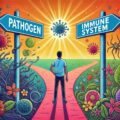Plant Fiber – The Secret Weapon Against Chronic Illness
 There is endless talk about which diet is the best for your health. They chant, “high protein is the best”, or “embrace the fats”, but rarely do we hear about plant fiber, the most important part of a healthy diet. With it, our body functions normally as the gut bacteria thrive. Without it, the body becomes acidic, toxic, inflamed and because of it, we suffer. In this article, I will discuss the value of fiber, while exposing a few dietary myths along the way.
There is endless talk about which diet is the best for your health. They chant, “high protein is the best”, or “embrace the fats”, but rarely do we hear about plant fiber, the most important part of a healthy diet. With it, our body functions normally as the gut bacteria thrive. Without it, the body becomes acidic, toxic, inflamed and because of it, we suffer. In this article, I will discuss the value of fiber, while exposing a few dietary myths along the way.
Protein Overload: Silent Assassin
In Western society, we have become fixated on protein and carbs. The reality is, far more people are concerned about their protein intake than they’ve ever been about fiber. This is the most damaging misconception amongst the public. None of the chronic illnesses are due to protein deficiency, yet many of them are due to fiber deficiency.
The reality is, unless you’re planning to enter a bodybuilding competition, you don’t need so much protein! Eating too much animal-derived protein can cause stress on your liver, kidneys, gallbladder, gut microbiome, gut lining, heart, arteries, and more. Most importantly, it can aggravate your mast cells, leaving them on high alert and ready to create inflammation.
Want to learn more about the history of meat consumption and how it’s overabundance has affected our health? Listen to Dr. Zach Bush’s podcast, The Protein Myth. It will be an eye-opener about why our culture has emphasized the consumption of protein.
Fats Instead of Carbs is Crazy
There are many people who claim that a diet high in fat/protein and low in carbohydrates is the best way to eat. This forces your body to use fat as its energy source and keeps your blood sugar low, in theory. The problem is the high-fat diet leads to elevated cholesterol levels in the blood, which block insulin receptors. This eventually makes you more sensitive to spikes in your blood sugar because your insulin receptors are not receiving sugar like they once were before. This leads to conditions like type two diabetes and other problems.
In addition, a high-fat diet can disrupt the gut microbiome by feeding problematic gut bacteria and encouraging the development of leaky gut. If the fat molecules are not fully digested, they initiate inflammation of the stomach lining, which causes aggravation of the immune system and much more.
If that wasn’t enough, high-fat diet can eventually cause gallstones, impaired bile production, and liver stagnation. This impairs normal detoxification which increases cellular oxidation and stress within the body. The key point to remember is, though a high fat/protein diet may provide desirable results over the short term, it is a recipe for disaster in the long run.
Fiber: The Forgotten Friend
Everyone talks about protein, fat, and carbohydrates, but what about fiber? The irony is, fiber is most important for keeping your immune system calm and inflammation under control. You can eat a diet low in protein, fat, OR carbohydrates and still be healthy. In contrast, a diet low in fiber typically equates to health problems in the long run. In the next section, I will discuss some of the health issues that can arise from a low-fiber diet.
Fiber Deficiency Leads to Inflammation
When your diet is low in fiber, it typically must be high in protein, fat, or simple carbohydrates. Excess in either of these areas causes acidosis in the body and encourages the growth of bad bacteria in your gut. As those bacteria start to dominate more and more, your gut becomes more inflamed by their byproducts. This eventually leads to a barrage of inflammatory signals being sent throughout the body. None of this is fun, and the key point is it could have been avoided with a fiber-dominant diet.
Key Benefits of Plant Fiber Consumption
Plant Fiber Increases SCFA Production
When you eat plant fiber, the fibrous part is undigested in the small intestine. It then travels to the large intestine, where it is gobbled up by those good bacteria that keep you healthy. When the beneficial bacteria ferment the fiber, they produce a byproduct known as a short-chain fatty acid. Different types of SCFAs are produced based on the bacteria and the type of fiber they ferment. These SCFA’s signal the immune system, letting it know that everything is OK. If we don’t have sufficient fiber, then we don’t have enough SCFA’s. This deficiency leads to signaling issues with the immune system, causing inflammation to increase throughout the body.
Fiber is Key to Gut Health
Plant fiber feeds the bacteria in your gut that keep you healthy. These bacteria use plant fiber as their fuel source. If your diet includes more animal products, processed foods, etc., you start to feed the bacteria responsible for creating inflammation. Though you may not notice right away, eventually it catches up with you over time.
Just remember, plant fiber is your friend, and everything else is a potential risk. The reason being, plant fiber is the only thing that exclusively feeds the good bacteria.Though this concept doesn’t sound too exciting to embrace, it’s true. Especially if you are someone who is dealing with a chronic illness.
Plant Fiber Aids in Detoxification
Fiber is like a sponge that sweeps up the mess in your gut. It cleans the gut walls, and pushes through the waste that would have otherwise been recirculated. Without fiber, you put tons of stress on your liver and kidneys. This is because they have nothing to help bind to the toxins in your stomach, so they just recirculate in your blood. These toxins are eventually removed by the kidneys/liver or are stored somewhere in the body.
If you want a cleaner body, you should consume less protein and eat mostly healthy fats in the proper amounts. Though this sounds good in theory, you must have a solid foundation that keeps your blood sugar stable to accomplish this. This is where fiber comes in. Fiber expands your stomach, which tells it to send a message to your brain that it is full. By keeping your blood sugar stable for longer, a high-fiber diet allows you to consume less protein and fat, which is much easier on the gut. In my experience, it is hard to maintain the low protein and healthy fat strategy without leaning heavily on fiber. Without it, things fall apart like a house of cards.
Transitioning from Meat to Fiber
If you are eating meat/animal products 2 to 3 times per day, you want to start reducing it when transitioning towards a high-fiber diet. Choose the fruits or vegetables that your body agrees with and start to include them more and more as you decrease animal products. Ideally, your initial goal is to have one serving of animal products per day, and the rest being plants. Once you have accomplished this, then you can start consuming it every every other day and so on. You can choose to keep meat around here and there, but remember, you don’t need it.
The key point is that you must slowly increase your fiber while simultaneously decreasing your protein. Also, foods that are really fiber-dense, like apples or flax, may take more time to get used to. Start with whatever your body tolerates best and gradually work your way in. Make this a gentle transition over an extended period of time so you embrace it as a lifestyle rather than calling in a diet.
Plant-Based Diet is the Best Choice
I ate meat every day for 36 years, and then went completely plant-based for a few years. In my experience, eating a plant-based diet with some animal products here and there is the best of both worlds.. You get a fiber-dominant diet that has a wide variety of plants, but then also get a little bit of animal products here and there. For example, I may have cheese every week or two, I drink 8oz of raw colostrum a few days a week, chicken once a month, etc.
Regardless, I always make sure that at least 80 to 90% of my food is plant-derived. This ensures that my good bacteria are the main ones being fed, and because of that, my inflammation is constantly under control. In addition, when I do consume animal products, I prefer it to be something cultured, like yogurt, fermented colostrum, etc. This makes the animal product potentially useful for your gut and immune system.
Frequently Asked Questions about Plant Fiber
What qualifies a food as being high in fiber?
If a food has more than four times the amount of carbohydrates than it does fiber, it is not a high-fiber food. Despite this, it doesn’t mean that these foods should be avoided. All types of plant fibers are important, but I would emphasize the ones with the best fiber-to-carbohydrate ratio. This helps your blood sugar to remain more stable which leads to better overall health.
How much fiber should I try to get each day?
The answer to this depends on your current intake of fiber. You should shoot for increasing your daily fiber intake by 5 to 10 g per day. At the same time, simultaneously reduce animal products. This will allow your gut bacteria to adapt to the fiber properly. Once you are at 60 to 70 g of fiber per day and you are getting a wide variety of plants, you are good to go.
Is it important to get various types of fiber?
Yes, you don’t want to eat just a few different types of fruits and vegetables. Your goal is to have plenty of variance in plant fiber. Ideally, you want to be eating 20 to 30 different types of plants per week. This is because each type of fiber feeds a different colony in your gut. The more diverse your beneficial bacteria are, the healthier your immune system will be.
Is it possible to have too much fiber?
Yes, it is possible to have too much of anything. The important thing to remember about fiber is that you must gradually increase your consumption of high-fiber foods. If you don’t, you may end up feeling stuffed or bloated. Regardless, it should only take a few weeks for your body to adjust to this high-fiber way of living. Just stick it out and make your changes gradual. As you increase the fiber, make sure to decrease the meat and animal products at the same rate. This is the key to success!
How can I stay full without meat?
This is what I thought when I initially started. Now I am less hungry than I ever was when I was eating meat. First of all, your goal is not to be full, it is to not be hungry. If you eat until you are full, you are putting stress on the body and immune system. Meat makes you feel full because it is so hard to digest. Though it will make you feel full, it does not stabilize your blood sugar like fiber. The reason is, when you have a food that is high in fiber, the insulin release is gradual. This makes sure the insulin doesn’t spike, so you don’t end up with a sugar crash and extremely hungry. Trust me, I now eat fewer calories than ever since adopting a plant-based diet (for the most part).
Conclusion: Plant Fiber is Secret to Good Health
Despite what others may claim, plant fiber is the most important component to maintaining health. If you don’t believe me, check the hundreds of scientific studies that support my claim.
If you are struggling with a chronic illness, fiber is critical to retaining progress during your healing journey. It is the one thing you can eat that good bacteria can benefit from, but pathogens can’t. Give it some time, and your body will adjust to this new way of eating. Once your body starts tolerating fiber better, you are on your way to recovery.
If you’re having trouble making the transition, just start slow. Even increasing your fiber by a little bit every other day is moving in the right direction. The key is also reducing animal products simultaneously, both in frequency and portion size. If you don’t do that, your body may not fully agree with the increase in fiber.
Think you may need help making these dietary changes? Have any health-related questions you want to run past me? If so, get in touch. That’s what I am here for!
Happy healing everyone!
Matt Nedin, B.S.
Certified Holistic Nutritionist
EndSickness, Founder
Phone: (734) 846-8619
WhatsApp: +17348468619
Email: endsickness@gmail.com












